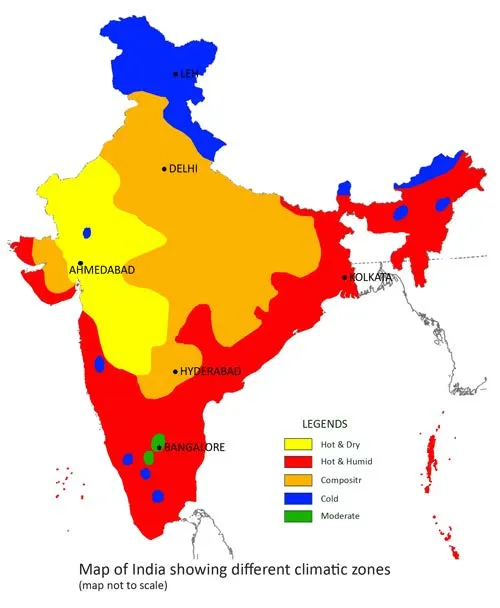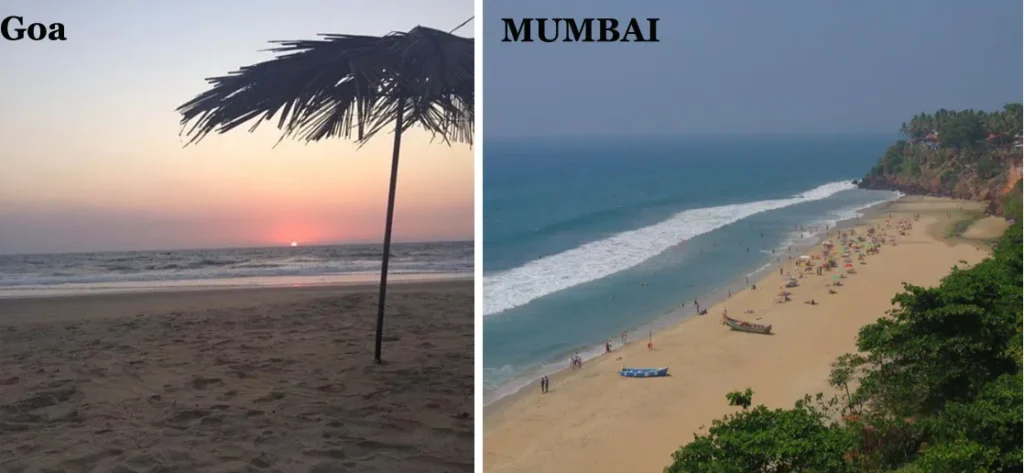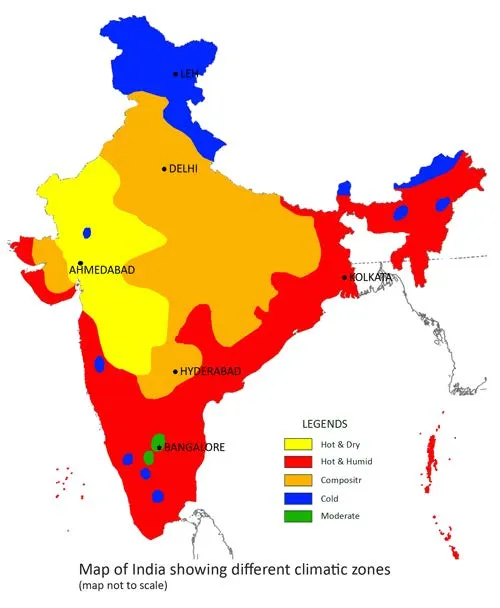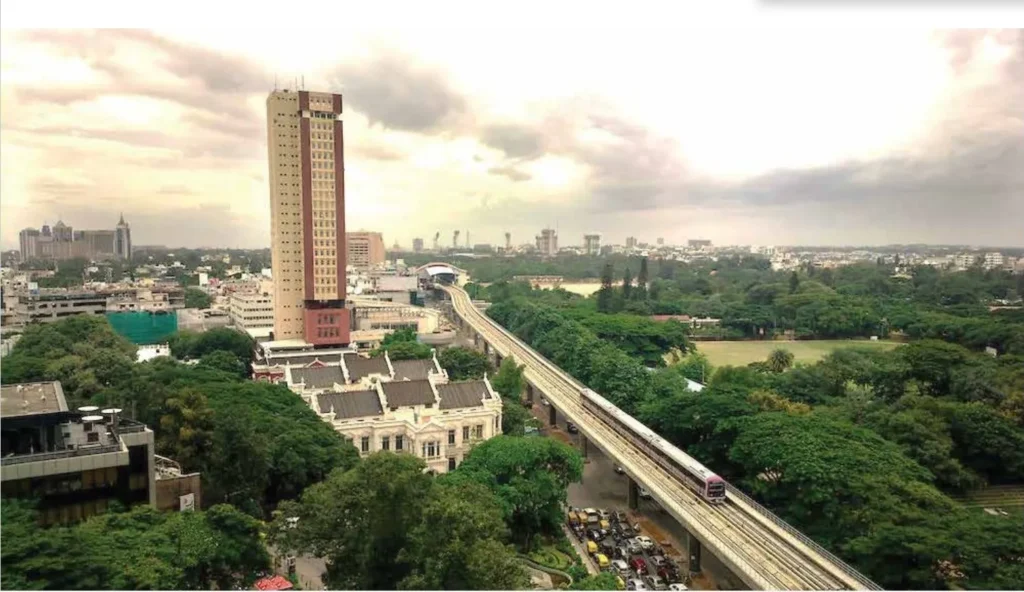If you want to know about the principles of daylighting design or climate and elements of climate or site climate, please click the link.
India is a country with a diverse geography and as a result, it has a variety of climatic zones. These climatic zones are broadly categorized into five types.
There are majorly Five climatic zones in India.
- Hot and dry
- Warm and humid
- Composite
- Cold
- Moderate
1) Hot and dry
- The hot and dry zone lies mostly in the western part of India.

- For ex. Jaisalmer, Jodhpur, Sholapur, Ahmedabad and Rajasthan are some of the towns that experience this type of climate.
i) Characteristic of hot and dry climate
- Winters are mainly dry.
- Hot dry weather in summer & cold in winter.
- Amount of rainfall & humidity is very less.
- Sandy or rocky ground with very low vegetation cover.
- Condition of the sky is clear most of the year.
ii) Jaisalmer – hot and dry climate

iii) Hot and dry : Case of jaisalmer
- Month : June
Latitude : 26ᵒ 54’ N
Longitude : 70ᵒ 55’ E
- Maximum possible sunshine : 13.01 hr.
- Maximum Air temperature : 41 ᵒc
- Avg. precipitation : 6.8MM (Low, generally less than 500mm per year)
- Relative humidity : 31% (very low 25-40%)
- Wind : Dust laden local winds (often developing into sandstorms)
- Sky condition : cloudless skies with higher solar radiation. Occasional darkening of the sky due to sandstorms.
- Solar radiation : Intense(800-900 W/m2)
- Landscape and vegetation : Relatively flat, sand or rocky ground, low water table, scarce vegetation .
2) Warm & humid climate
- Warm and humid zone lies in the southern and eastern part of the India.

- For ex. Goa, Mumbai, Vishakhapatnam, Chennai, Kolkata, Puri (Orissa), Tripura, Gulf of Kutch etc.

i) Characteristics of warm & humid climate
- There is slightly seasonal variation throughout the year.
- There are long monsoon periods with heavy rain But the breezes, especially in coastal areas, can alleviate discomfort considerably.
- Humidity remains high, about 75% most of the time.
- Precipitation is high throughout the year.
- Sky conditions are fairly cloudy throughout the year.
- Solar radiation is partly reflected & partly scattered by the cloud blanket.
- Wind velocities are typically low.
ii) Warm and humid : Case of guwahati
Month : June
Latitude : 27ᵒ 04’ N
Longitude : 93ᵒ 34’ E
- Maximum possible sunshine : 13.5 hr.
- Maximum Air temperature: 31.5 ᵒc
- Avg. precipitation : 293MM (high ,1200mm per year)
- Relative humidity : 89% (70-90%)
- Wind : usually one or two prevailing directions with velocities ranging from extremely low to very high ( during rain storms)
- sky condition : Generally overcast (cloud ranging between 40and 80% causing unpleasant glare.
- Solar radiation : Intense radiation on clear days ,diffuse radiation (causing painful glare) due to cloud cover or vapour content of the air.
- Landscape and vegetation : Generally low altitude and latitude .
3) Composite Climate of India
- Composite zone lies mostly in the central part of the India .

- For ex. New Delhi , Lucknow , Allahabad
i) Characteristic of composite climate
- Composite or monsoon climates are neither constantly hot and dry, nor warm and humid.
- Courtyard type buildings are very suitable.
ii) Composite climate : Case of new delhi.
Month : June
Latitude : 28ᵒ 35’ N
Longitude : 77ᵒ 12’ E
- Maximum possible sunshine : 14.02 hr.
- Maximum Air temperature : 38.5 ᵒc
- Avg. precipitation : 6.5MM (500-1300 mm per year during monsoon, no rain in dry season )
- Relative humidity : 56% ( in dry season 20to 55% , in wet season 55to 95%)
- Wind : Hot & dusty during summer, strong winds in monsoon from southwest, dry and cold winds in winter from northwest.
- Sky condition : Dull in the monsoon , clear during summer, dust & haze during the summer period.
- Solar radiation : Intense in summer and winter with a low % of diffuse radiation.
- Landscape and vegetation : extremely variables landscape with rapid seasonal changes in vegetation.
4) Cold climate
- Cold climate zone lies mostly in the eastern and northern part of the India.

- For ex. Himanchal Pradesh, Leh laddakh, Darjeeling , Arunanchal Pradesh, Sikkim etc.
i) Characteristics of cold climate
- RH varies between 45 to 99%.
- Precipitation is variable, but rarely less than 1000 mm.
- Sky conditions are normally clear or partly cloudy to the extent of about 40%.
- Winds are variable, predominantly north- east & south easterlies, but may be drastically deflected by local topography.
- Vegetation is green although not very luxuriant during the wet season.
- Heavy dew at night.
ii) Cold and sunny : Case of leh
Month : June
Latitude : 34ᵒ 09’ N
Longitude : 77ᵒ 34’ E
- Maximum possible sunshine : 14.26 hr.
- Maximum Air temperature : 18.5 ᵒc
- Avg. precipitation : 4.3MM (very low generally less than 200mm per year )
- Relative humidity : 31% (10-50%)
- Wind : occasionally intense
- Sky condition : fairly clear throughout the year with cloud cover less than 50%
- Solar radiation : intense with low percentage of diffuse radiation
- Landscape and vegetation : mountainous region with little vegetation

iii) Cold and cloudy : Case of shimla
- Month : June
Latitude : 31ᵒ 06’ N
Longitude : 77ᵒ 12’ E
- Maximum possible sunshine : 14.01 hr.
- Maximum Air temperature : 24.3 ᵒc
- Avg. precipitation : 147.5 (annual total around 1000 mm)
- Relative humidity : 53% ( various between 70-80%)
- Wind : Generally intense during rainfall, mainly depend upon topography.
- Sky condition : overcast for most part of the year, except during the brief summer period.
- Solar radiation : low in winter with a high % of diffuse radiation
- Landscape and vegetation : highland region with abundant vegetation in summer.
5) Moderate climate
- Moderate climate zone lies in the southern part of the India .

- For ex. Bangalore .
i) Characteristics of moderate climate
- It has mild to warm summers & cool winters.
- It is relatively comfortable climate, especially near the coast, where summers are cooler & winters warmer than further inland.
- In the mountains of Great Diving Range, winters are cold & summers are pleasantly mild.
- Few openings on external side other than door.
- Pune & Bangalore are examples of cities that fall under this climatic zone
ii) Bangalore – Moderate Climate

iii) Moderate : Case of banglore
Month : June
Latitude : 12ᵒ 56’ N
Longitude : 77ᵒ 35’ E
- Maximum possible sunshine : 12.5 hr.
- Maximum Air temperature : 29ᵒc
- Avg. precipitation : 65MM (fairly well distributed over the year, total annual rainfall exceeding 1000mm, dry winters)
- Relative humidity : 56% (30-80%)
- Wind : High during summer.
- Sky condition : Mainly clear, occasionally overcast with dense low clouds in summer.
- Solar radiation : More or less uniformly moderate all through the year
- Landscape and vegetation : Generally hilly or high plateau region with fairly abundant vegetation
It’s important to note that the climatic zones in India are not static and can vary depending on several factors such as altitude, latitude, and proximity to the ocean.